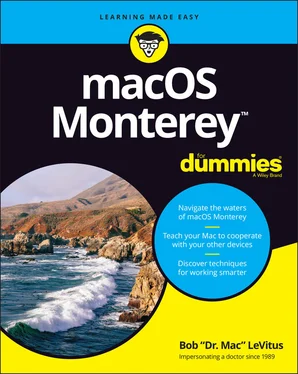Information about programming for the Mac: This book is about using macOS Monterey, not writing code for it. Dozens of books — most of which are two or three times the size of this one — cover programming on the Mac.
Within this book, you may note that some web addresses break across two lines of text. If you’re reading this book in print and want to visit one of these web pages, simply key in the web address exactly as it’s noted in the text, pretending as though the line break doesn’t exist. If you’re reading this as an e-book, you’ve got it easy — just click the web address to be taken directly to the web page.
Although I know what happens when you make assumptions, I’ve made a few anyway.
First, I assume that you, gentle reader, know nothing about using macOS — beyond knowing what a Mac is, that you want to use macOS, that you want to understand macOS without having to digest an incomprehensible technical manual, and that you made the right choice by selecting this particular book. And so I do my best to explain each new concept in full and loving detail. Maybe that’s foolish, but … that’s how I roll.
Oh, and I also assume that you can read. If you can’t, ignore this paragraph.
Little pictures (icons) appear off to the left side of the text throughout this book. Consider these icons miniature road signs, telling you a little something extra about the topic at hand. Here’s what the different icons look like and what they all mean.
 Look for Tip icons to find the juiciest morsels: shortcuts, tips, and undocumented secrets about Monterey. Try them all; impress your friends!
Look for Tip icons to find the juiciest morsels: shortcuts, tips, and undocumented secrets about Monterey. Try them all; impress your friends!
 When you see this icon, it means that this particular morsel is something that I think you should memorize (or at least write on your shirt cuff).
When you see this icon, it means that this particular morsel is something that I think you should memorize (or at least write on your shirt cuff).
 Put on your propeller-beanie hat and pocket protector; these parts include the truly geeky stuff. It’s certainly not required reading, but it must be interesting or informative, or I wouldn’t have wasted your time with it.
Put on your propeller-beanie hat and pocket protector; these parts include the truly geeky stuff. It’s certainly not required reading, but it must be interesting or informative, or I wouldn’t have wasted your time with it.
 Read these notes very, very, very carefully. (Did I say very? ) Warning icons flag important cautionary information. The author and publisher won’t be responsible if your Mac explodes or spews flaming parts because you ignored a Warning icon. Just kidding. Macs don’t explode or spew these days. But I got your attention, didn’t I?
Read these notes very, very, very carefully. (Did I say very? ) Warning icons flag important cautionary information. The author and publisher won’t be responsible if your Mac explodes or spews flaming parts because you ignored a Warning icon. Just kidding. Macs don’t explode or spew these days. But I got your attention, didn’t I?
 Well, now, what could this icon possibly be about? Named by famous editorial consultant Mr. Obvious, this icon highlights things new and different in macOS Monterey.
Well, now, what could this icon possibly be about? Named by famous editorial consultant Mr. Obvious, this icon highlights things new and different in macOS Monterey.
In addition to what you’re reading right now, this product also comes with a free access-anywhere cheat sheet that provides handy shortcuts for use with macOS Monterey, offers my backup recommendations, and more. To get this cheat sheet, simply go to www.dummies.com and type macOS Monterey For Dummies Cheat Sheetin the Search box.
The first few chapters of this book are where I describe the basic things that you need to understand to operate your Mac effectively. If you’re new to Macs and macOS Monterey, start there.
Although macOS Monterey looks slightly different from previous versions, it works the same as always (for the most part). So, the first part of the book presents concepts so basic that if you’ve been using a Mac for long, you might think you know it all — and okay, you might know some (or most) of it. But remember that not-so-old-timers need a solid foundation, too. So here’s my advice: Skim through stuff you already know and you’ll get to the better stuff sooner.
I would love to hear how this book worked for you. As mentioned, sending me your thoughts, platitudes, likes, dislikes, and comments will make me a happy author. Did this book work for you? What did you like? What didn’t you like? What questions were unanswered? Did you want to know more (or less) about something?
I have received more than 100 suggestions about previous editions, many of which are incorporated here. So please (please!) keep the tradition alive and email me at Monterey4Dummies@boblevitus.com with your suggestions .
I appreciate your feedback, and I try to respond to all reasonably polite email within a few days.
So what are you waiting for? Go on and enjoy the book!
Part 1
IN THIS PART …
Find the most basic of basics, including how to turn on your Mac.
Make the dock work harder for you.
Get a gentle introduction to Finder and its desktop.
Find everything you need to know about Monterey’s windows, icons, and menus (oh my)!
Get all the bad puns and wisecracks you’ve come to expect.
Discover a plethora of Finder tips and tricks to make life with Monterey even easier (and more fulfilling).
Chapter 1
macOS Monterey 101 (Prerequisites: None)
IN THIS CHAPTER
 Understanding what an operating system is and is not
Understanding what an operating system is and is not
 Turning your Mac on and off
Turning your Mac on and off
 Getting to know the start-up process
Getting to know the start-up process
 Avoiding major Mac mistakes
Avoiding major Mac mistakes
 Pointing, clicking, dragging, and other uses for your mouse
Pointing, clicking, dragging, and other uses for your mouse
 Getting help from your Mac
Getting help from your Mac
Congratulate yourself on choosing macOS Monterey version 12.0, also known as the 18th release of the venerable operating system formerly known as OS X (which was pronounced “oh-ess-ten”). Now, congratulate yourself again for making your Mac even easier to use, with hundreds of tweaks to help you do more work in less time, plus a user interface overhaul that once again affects almost every pixel on the screen.
In this chapter, I start at the very beginning and talk about macOS in mostly abstract terms; then I move on to explain what you need to know to use macOS Monterey successfully. A number of features I describe haven’t changed in years (other than adopting the updated Monterey graphic look), so if you’ve been using macOS for a while, much of the information in this chapter may seem hauntingly familiar.
Читать дальше

 Look for Tip icons to find the juiciest morsels: shortcuts, tips, and undocumented secrets about Monterey. Try them all; impress your friends!
Look for Tip icons to find the juiciest morsels: shortcuts, tips, and undocumented secrets about Monterey. Try them all; impress your friends! When you see this icon, it means that this particular morsel is something that I think you should memorize (or at least write on your shirt cuff).
When you see this icon, it means that this particular morsel is something that I think you should memorize (or at least write on your shirt cuff). Put on your propeller-beanie hat and pocket protector; these parts include the truly geeky stuff. It’s certainly not required reading, but it must be interesting or informative, or I wouldn’t have wasted your time with it.
Put on your propeller-beanie hat and pocket protector; these parts include the truly geeky stuff. It’s certainly not required reading, but it must be interesting or informative, or I wouldn’t have wasted your time with it. Read these notes very, very, very carefully. (Did I say very? ) Warning icons flag important cautionary information. The author and publisher won’t be responsible if your Mac explodes or spews flaming parts because you ignored a Warning icon. Just kidding. Macs don’t explode or spew these days. But I got your attention, didn’t I?
Read these notes very, very, very carefully. (Did I say very? ) Warning icons flag important cautionary information. The author and publisher won’t be responsible if your Mac explodes or spews flaming parts because you ignored a Warning icon. Just kidding. Macs don’t explode or spew these days. But I got your attention, didn’t I? Well, now, what could this icon possibly be about? Named by famous editorial consultant Mr. Obvious, this icon highlights things new and different in macOS Monterey.
Well, now, what could this icon possibly be about? Named by famous editorial consultant Mr. Obvious, this icon highlights things new and different in macOS Monterey. Understanding what an operating system is and is not
Understanding what an operating system is and is not










